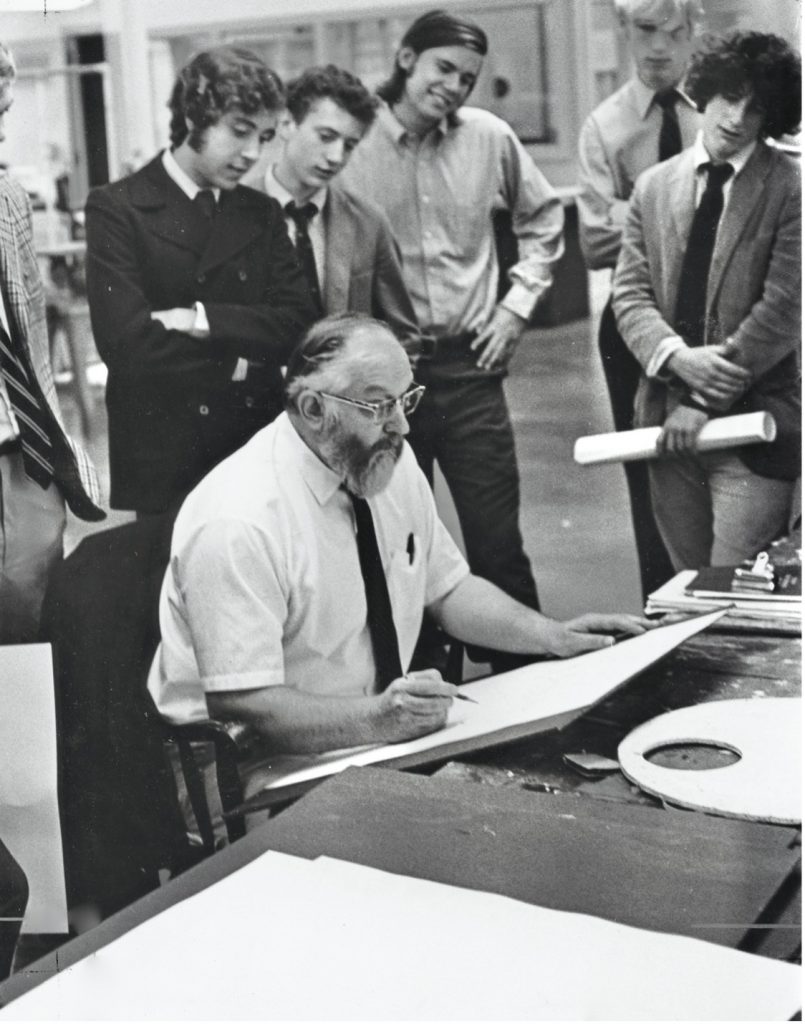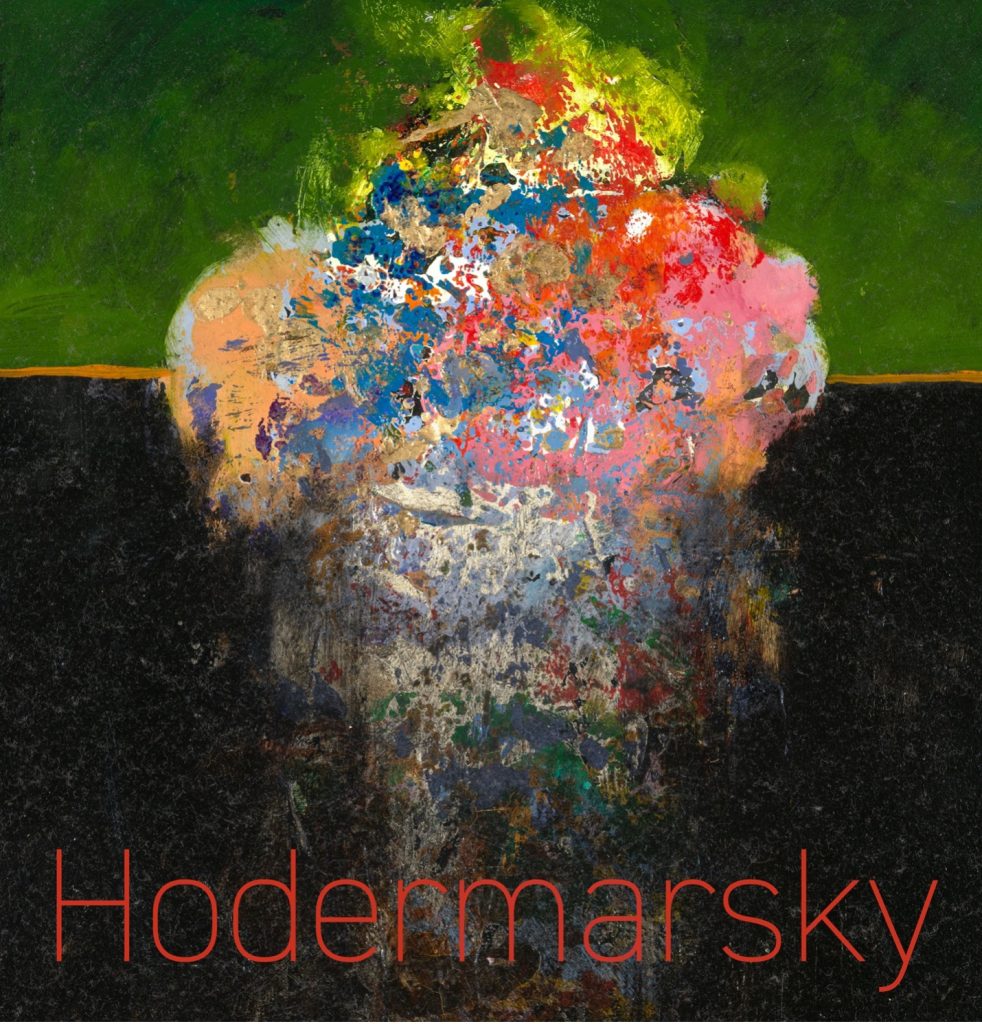In the world of art, there are stories that surpass brushstrokes on canvases, tales that resonate with the human spirit, and narratives that transcend time. One such story is that of the artist Daniel Hodermarsky (1924–1999). To those who knew him he was a force of nature, a force of art, and an unquenchable force of life.
The echoes of World War II still reverberate through modern history. Hodermarsky, 19 when he went to war, was a veteran of the Western front and served in the 400th Armored Artillery Battalion—the so-called “Bastard Battalion” that was sent wherever artillery was needed and thus experienced combat 95% of the time during its 9-month tour across Europe. He earned accolades and honors for his valor, but the scars of war ran deep, and he returned home with severe and chronic post-traumatic stress disorder (PTSD) that would dog him throughout his life. Ultimately, it was in his art that Hodermarsky found solace and healing, creating over his lifetime a visual testament to the transformative power of creativity.
In the aftermath of war, art became a means of catharsis and redemption for Hodermarsky. His canvases became a sanctuary where he could give the unspoken and unspeakable form and substance. “He painted because he had to,” his daughter Maria says of her father. “It was his way of taking in the world, of responding. . . , of processing, of valuing. . . . His art allowed his many unspoken, unspeakable experiences to be metabolized and rendered on canvas. Through making art he could step away from those experiences—physical, existential, emotional—and move the experiences from formlessness to form.” Through the act of creation, he navigated those haunting memories and shaped them into tangible expressions that he could share with others, and exorcise, to some extent, the excruciating memories of agony and death on the battlefield. The result became a comprehensive body of work that invites viewers to witness the process of channeling traumatic experiences into creative expression. A deeply compassionate man with an often-outrageous sense of humor and an enormous capacity for love, he maintained a positive, sanguine view of life despite ample evidence to the contrary. “It is often heathen, sensual, and profane,” he wrote, “but it is optimistic.”
Hodermarsky’s artistic portfolio is unique in its nuanced exploration of diverse series, each serving as a chapter in his emotional and creative journey. A particularly poignant collection is his War Series, wherein Hodermarsky employs a gestural and borderline abstract style to encapsulate the stark realities of conflict. From political figures to troops navigating snow-covered terrains, to the carnage of battle, the series reveals the raw and often grisly reality of war, particularly for those who have never experienced combat.
What distinguishes Hodermarsky’s work is the unique transition between series, reflecting his personal evolution. The landscape pieces that follow the War Series exude tranquility, signaling a profound shift in the artist’s psychological terrain. Nature becomes his muse and ethereal landscapes emerge, capturing the essence of the artist’s journey toward healing. His explorations extend to a diverse array of subjects—animals, women, seated figures, politicians, and businessmen, as well as intimate self-portraits. His works range from the abstract to the purely figurative. His mastery is evident across various mediums, including oils, watercolors, and drawings, with each medium contributing to the rich tapestry of his narrative. In essence, Hodermarsky’s work offers viewers not only a glimpse into the harrowing realities of conflict but also an intimate experience of the artist’s profoundly positive, humanistic vision that endured over the course of his artistic evolution.

Beyond the canvas, Hodermarsky had a distinguished teaching career that spanned more than three decades. From 1957 to 1969, he shared his passion for art at the Cleveland Institute of Art; in the 1960s, he pioneered an art program for inner-city youth, promoting integration through arts education. His educational influence continued at Deerfield Academy in western Massachusetts from 1969 to 1989, where he founded the school’s art department, served as its department chair, and directed the school’s Hilson Gallery. During his tenure there, he mentored notable contemporary artists, including Stephen Hannock and Michael Tracy.
In an interview done for the book, Stephen Hannock recounts, “Dan never approached me as an artist. He never approached anyone as an artist. He related to everybody in his classes as young men trying to figure it all out. And it was during this time that art just happened for me. From that time until now, I have never met another artist who related to other artists that way: that if you embraced your complete life, art would happen on its own. . . . In 1970, Hodermarsky’s rooms were such nonjudgmental havens that everybody flocked to them. Whether they were taking an art class or not. . . . Dan listened better than any teacher I can remember. Dan was just glued to listen.”
He retired in 1989, and there followed 10 blissful years of painting on Deer Isle, Maine. He died working in his studio as he likely would have wished had he a choice. Reflecting his Slavic heritage, he surely would have enjoyed, and laughed heartily, that kielbasa was served at his memorial service.

The Artist Book Foundation (TABF), a nonprofit fine-art book publisher, has undertaken the task of chronicling Hodermarsky’s life and art in a forthcoming publication. The book, simply titled Hodermarsky, is more than a retrospective; it is an exploration of an artist’s triumph over adversity, a documentation of the interplay between war and creation, and a celebration of the complexities that define the human experience.

As the February 2024 release date of Hodermarsky approaches, TABF invites readers to step into the world of this extraordinary artist. The book, a carefully curated collection of his works and an intimate exploration of his life, will be a remarkable visual and emotional journey, further enriched by insightful essays from esteemed figures in the art world that offer nuanced perspectives on Hodermarsky’s creations. Additionally, an insightful essay from an art therapist adds a unique perspective, providing an examination of the emotional dimensions within Hodermarsky’s compelling body of work. This publication is an opportunity to witness the interplay of joy, reverence, and passion that defines Hodermarsky’s enduring legacy.
In a world where art often serves as a mirror to society, Hodermarsky’s story stands as a testament to the transformative power of creativity. From the battlefield to the classroom, from personal trauma to communal understanding, his life and art intertwine in a narrative that speaks to the resilience of the human spirit. Toward the end of his life he wrote, “I have loved people, the sea, sky, land, animals. I have avoided success and tried hard to recognize what love really is.”
__________________________
Author Bio:
The Artist Book Foundation (TABF) is a nonprofit art book publisher that celebrates artists’ lives and work through publications, related exhibitions, and public programs. TABF works collaboratively with artists, museum curators, art historians, and collectors to develop catalogues raisonnés, monographs, surveys, and exhibition catalogues. It is dedicated to preserving and celebrating the artistic legacy of acclaimed as well as underrepresented artists. With a focus on producing artist-centered publications that delve into the lives and works of these remarkable individuals, TABF plays a vital role in fostering appreciation for the arts and their lasting impact on culture and society. Additionally, TABF’s book donations program provides access to the arts to the widest audience possible by delivering thousands of copies of their publications to underserved public libraries, schools, and prisons across the country.
